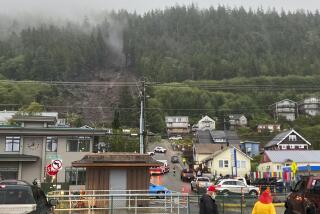Brutal Cold Cuts Off Alaskan Villages; Supplies Dwindle
- Share via
ANCHORAGE, Alaska — Supplies in outlying Alaskan villages dwindled Saturday when delivery trucks were idled by flat tires caused by a brutal cold snap that prompted the governor to declare a state of emergency.
The official low for the 12 hours ending at 4 p.m. Saturday was 69 degrees below zero at Farewell Lakes near McGrath. The weather service said it also received an unofficial reading of 86 degrees below zero at a lodge near McGrath, northwest of Fairbanks.
The state’s all-time low is 80 degrees below zero, recorded at Prospect Creek in 1971.
25 Below at Anchorage
Midday temperatures elsewhere in Alaska on Saturday included 25 below zero at Anchorage and 44 below at Barrow and Fairbanks. The normal low for January is 6 degrees in Anchorage and 21 degrees below zero at Fairbanks, the National Weather Service reported.
No serious injuries have been blamed on the cold, but Gov. Steve Cowper issued an emergency declaration Saturday to help make state funds available for emergency services.
Delivery systems have been disrupted to rural villages statewide, causing shortages of essential items, Cowper said. Other villages were experiencing cold weather-related problems in the operation of water, sewer, power and heating systems.
The American Red Cross said it opened an emergency shelter at Port Graham on the Kenai Peninsula and would open a shelter in Anchorage because the cold wave threatened to force people from their homes.
The Anchorage shelter could handle about 100 people, said Joyce Murphy, vice chairman of the Red Cross disaster committee. Another facility in the city would be opened if response exceeded that figure, she said.
Cold Flattens Tires
In Tanana, about 125 miles northwest of Fairbanks, the driver of a truck that picks up groceries and mail at the airport was unable to make his rounds. Pete Platten said the record cold flattened three of the truck’s tires.
“There’s no give to the tires at this temperature,” Platten said. “They get a flat spot from sitting, and they pop the bead from around the rim or crack at the base of the valve stem when you go to drive.”
The operator of a store at Tanana predicted that supplies would last only a few days longer.
“Then we’ll be running out of things--bread, eggs and milk,” Dale Erickson said. The store already was out of Blazo, a fuel for portable heaters.
Because small planes cannot fly in extremely cold weather, many of Alaska’s 200 villages have been without mail and food delivery for two weeks.
Guard Stands By
The Alaska National Guard stood by to provide food and fuel airlifts to villages needing them, Cowper said on Friday. Mail and food supplies are stacking up in hub airports such as those at Nome and Kotzebue, he said.
In Anchorage, a municipal sewage plant operator said that during the last two weeks calls had been coming in at the rate of 20 to 30 a night from residents with frozen sewer lines.
Mail carriers in the city were told to stay outside for no longer than 10 minutes at a time, then retreat to their vehicles or the indoors.
Weather service officials said the extreme cold could continue for another week or two in interior Alaska. Meteorologists attributed the brutal temperatures to a mass of cold air they call the Omega Block.
More to Read
Sign up for Essential California
The most important California stories and recommendations in your inbox every morning.
You may occasionally receive promotional content from the Los Angeles Times.













